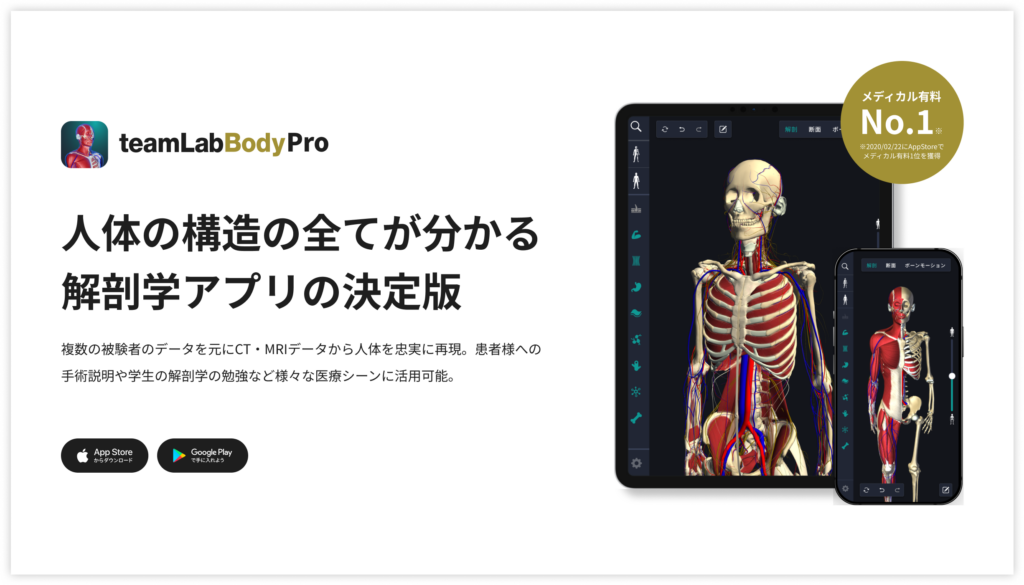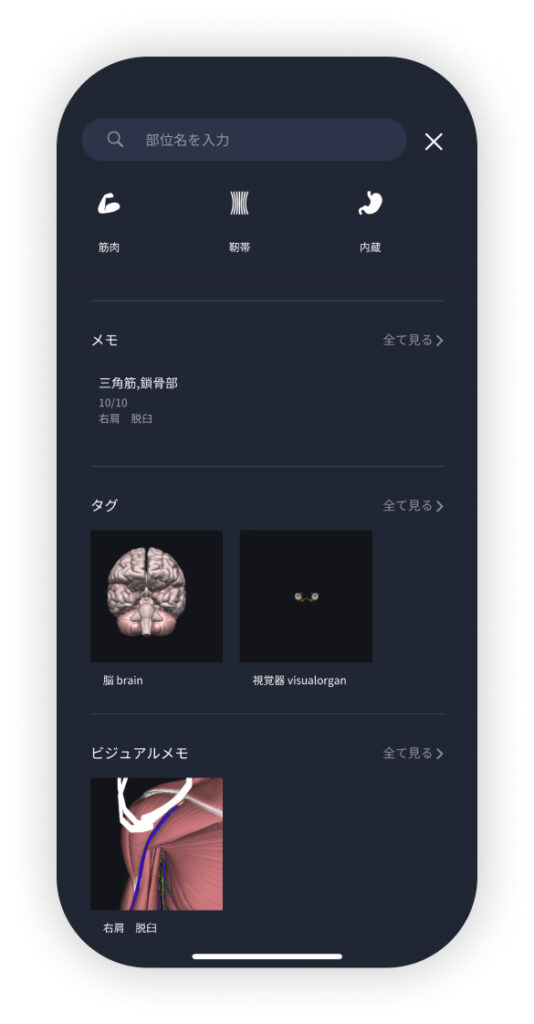beginning
In this article, I will explain effective study methods, starting with knowledge of specialized parts in human anatomy.
In human anatomy, it is necessary not only to memorize the names of various organs, muscles, and bones, but also to remember where they are located in the body. Therefore, it is necessary to learn as efficiently as possible.
I hope you will deepen your understanding even a little by reading this article and using the app.
Now, I'll explain the details about the “sternocleidomastoid muscle” and how to study human anatomy.
teamLab Body Pro Free Download
A 3D anatomy app that shows all the structures of the human body
Download teamLab Body Pro here!

What is sternocleidomastoid muscle?
The anatomy application allows you to view a selection of anatomy 3D models. In this model, there are various observation methods such as surfaces, cross-sections, and nervous systems. This time, I'll explain using an anatomy application.
About sternocleidomastoid muscle

The sternocleidomastoid muscle (sternocleidomastoid muscle) is a neck muscle that starts at the top of the sternum (sternum) and clavicle (clavicle) and is inserted into a part of the skull called the mastoid process (mastoid process). The sternocleidomastoid muscle is an important muscle that controls neck movement, and is mainly responsible for helping the head rotate and flex.
This muscle rotates the head to the other side when only one side contracts, and flexes the neck forward when both sides contract simultaneously. Also, since the muscles on both sides contract, it is also possible to tilt (stretch) the neck backwards. In everyday life, the sternocleidomastoid muscle plays an important role when looking back and tilting the neck.
Decreased sternocleidomastoid muscle function can reduce the neck's range of motion and be painful. Neck and shoulder pain can also occur due to muscle tension or stiffness. For this reason, it's important to keep your sternocleidomastoid muscles flexible and strong. By stretching, exercising, and improving posture, you can maintain muscle function and prevent pain.
Study points
Anatomical understanding
The sternocleidomastoid muscle (sternocleidomastoid muscle) is an important muscle located in the neck and is deeply involved in head movements. As a first step in learning, it's important to understand the anatomical location of this muscle. The sternocleidomastoid muscle starts from the sternum (sternum) and clavicle (clavicle) and is inserted into a part of the back of the skull called the mastoid process (mastoid process). This muscle runs diagonally from the front of the neck to the back.
When learning the sternocleidomastoid muscle, it is essential to first accurately understand where it starts and stops. Once you understand the basic structure of starting from the top of the sternum and the inside of the collarbone and attaching to the mastoid process of the skull, the location and role of muscles becomes more clear. Also, the left and right sides of this muscle exist symmetrically, and play an important role in rotating the head and moving it back and forth.
Using anatomical diagrams and 3D anatomy applications to improve visual understanding is very effective. This allows us to visually understand how the sternocleidomastoid muscle contributes to neck and head movements, and how it relates to surrounding muscles and nerves. Furthermore, in order to deepen the anatomical understanding of the sternocleidomastoid muscle, it is useful to learn the relationships with muscles located around it (for example, levator scapula muscle or trapezius muscle).
Understanding muscle function
The main function of the sternocleidomastoid muscle is to participate in head movements. Specifically, the sternocleidomastoid muscle plays an important role in neck rotation, flexion, and even extension. When this muscle contracts, the sternocleidomastoid muscle on one side works to rotate the head to the opposite side, and when both sides contract at the same time, it can flex the neck forward. Also, when the sternocleidomastoid muscles on both sides work, the head can be bent backwards (extended).
The sternocleidomastoid muscle is an essential muscle for moving the neck and changing gaze in everyday life. For example, sternocleidomastoid muscles play an important role when looking back or when tilting the neck to one side. Furthermore, this muscle is also involved during breathing, and the sternocleidomastoid muscle may act as an auxiliary muscle, especially when breathing becomes shallow.
When the function of the sternocleidomastoid muscle decreases, neck movement is restricted, and for example the neck may become painful or difficult to move. These problems can be prevented through stretches and exercises aimed at muscle flexibility and strengthening.
Practical applications
Understanding the sternocleidomastoid muscle is also very useful in clinical settings. In particular, appropriate treatment and rehabilitation can be performed for patients with neck and shoulder pain by understanding the role of sternocleidomastoid muscle. If the sternocleidomastoid muscle is overstrained, you often feel pain in your neck and shoulders, so relaxing this muscle is important as part of your treatment.
In rehabilitation, sternocleidomastoid stretches and exercises to increase muscle strength are useful. For example, by practicing turning the neck left and right and moving it back and forth, muscle flexibility can be improved and pain relief can be expected. Also, since sternocleidomastoid muscle is involved in head posture, it is possible to reduce the burden on the muscles by correcting posture.
In actual treatments, massages to relax muscles and guidance to improve posture to support the neck are effective. This allows the muscles around the neck to be used properly and also helps prevent pain. Rehabilitation targeting the sternocleidomastoid muscle is very important for improving the patient's quality of everyday life.
How to study human anatomy
I will explain specific study methods using human anatomy applications.
Check your past learning history and practice repeatedly
Here are the steps to check your anatomy learning history and practice iteratively effectively.
1. Check your learning history in the app
Reviewing your learning history with the application is an important step in effectively advancing anatomy learning. First, launch the app and go to the learning history section from the main menu. Many anatomy apps are designed to show your progress in the form of graphs and lists, so you can visually check which parts you've learned about and how much time you've spent.
By using this data, you can understand which areas you have strengths in and where you need to spend more time and effort. We also recommend using a dedicated tag or notebook function to mark areas you are particularly weak at or where you need to relearn. Regularly checking your learning history and looking back on past learning content will lead to efficient review and deepening understanding.
2.Make a plan for iterative learning
Making an efficient repetitive learning plan based on learning history is extremely effective in promoting knowledge retention. First, identify weak points and areas where you need to relearn. Next, arrange these study items into a weekly or monthly calendar and create a specific study schedule. By proceeding in a planned manner, you can learn each part evenly and avoid packing in a large amount of information at once.
Using a task management app or digital calendar to set study reminders is effective. Also, it's important to have the flexibility to regularly review progress and revise plans as needed. By having goals and proceeding with your studies in a planned manner, you can efficiently acquire anatomical knowledge.
3.Use 3D features to learn visually
By utilizing the 3D function, learning anatomy is easier to understand visually. The 3D model shows the structure of the human body three-dimensionally, and each part can be observed in detail. This makes it possible to intuitively grasp positional relationships between deep muscles and organs that are difficult to capture in a planar view. For example, you can learn even the smallest details by rotating specific muscles and bones and zooming in and out.
Also, there are many apps that have the function of displaying cross-sectional views of each part using a 3D model, which is useful for deepening understanding of internal structures. This diversity of visual information helps with memory retention and improves immediate responsiveness in tests and practice situations. By utilizing the 3D function and learning visually, you can learn anatomy knowledge more deeply and efficiently.
Use the memo function concretely

Make notes so you don't forget the things and points you've noticed while studying. The memo function can be used for different purposes, such as inputting text, saving images, and writing memos. Tag your notes to make them easier to review later.
Test your learning regularly in the form of quizzes
Regularly testing what you've learned in a quiz format is a very effective way to anchor your anatomy knowledge. Quiz-style tests help you objectively grasp your level of understanding and areas you lack while repeating knowledge.
For example, by using a learning app to conduct quizzes every specific period, you can reconfirm what you've learned and strengthen your memory. There are a wide range of quiz formats, such as multiple choice questions, fill-in-the-blank questions, and short answer questions, and each helps understanding from a different angle and develops the ability to utilize various types of knowledge.
Get feedback
If possible, get feedback from other learners and experts. It helps you find your own gaps in understanding and areas for improvement. You can also keep yourself motivated to learn by regularly testing yourself. Feeling a sense of accomplishment and progress increases motivation for continuous learning.
summary
This time, I explained how to study “sternocleidomastoid muscle” using an application!
Thank you for reading this far.
I would be happy if reading this article helped you learn about anatomy.
Learning is a long, never-ending journey, but I sincerely wish you all the best. Let's continue to study together and work hard for the national exam!
Please look forward to the next blog.
teamLab Body Pro Free Download
A 3D anatomy app that shows all the structures of the human body
Download teamLab Body Pro here!





